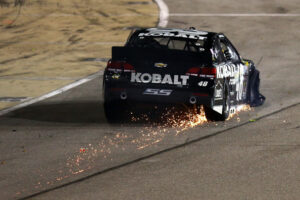NASCAR Shows Double Standard Alive and Well in the Chase for the Cup

This late race accident by Jimmie Johnson helped give his teammate, Jeff Gordon, a chance to pass many of the race leaders and remain within contention for the Chase.
With their rulings this week that ultimately ensured that NASCAR darlings Jeff Gordon and Ryan Newman were in the “Chase for the Cup”, NASCAR showed that manipulating results to benefit your teammates is only okay if done in a covert manner.
Much has been made of Clint Bowyer’s spin and the apparent attempts by some teams to help certain drivers (Martin Truex Jr. and Joey Logano) earn additional points to ensure their participation in the NASCAR Chase.
Based on the history of race manipulation in NASCAR, what they are really guilty of is not being stealth enough in their approach.
They need to work at emulating the expert performances of Hendrick Motorsport teammates Jimmie Johnson and Jeff Gordon. Two of the most successful drivers of the last decade, both drivers have well deserved reputations for bending ethics to ensure success.
Both drivers have more than a wall full of trophies earned as a result of knocking drivers out of their way, in many of those cases doing so by masking intentional unfair actions under the guise of “that’s just racing.”
So it should be no surprise that during the final green light pits of the Richmond race (and thus the last real big chance to alter chase order), Johnson mysteriously had a “tire get low” and banged into the wall just in time for Gordon, who seemed hopelessly out of the points race, to work his way through and pass many of the race leaders to suddenly get back in contention.
However, because of the controversy at the end of the race involving Bowyer and the others, Gordon and Johnson have received absolutely no scrutiny, other than by fans that understand and don’t agree with the two-tiered standard.
The reality is that the way racing works, it is extremely easy to manipulate the system in a covert manner to help your drivers receive positive outcomes. A well-timed spin here or pit stop there get great notice with seven laps left in the last race before the start of the Chase, but those same actions receive little notice when they occur during any of the first 25 races of the year.
If NASCAR really wanted to gain an understanding of how often teams manipulate positions through spins, wrecks or other deliberate actions, they would go back and review every occurrence in the last 100 laps of races over the entire course of the year.
My guess is that they would be overwhelmed by the high frequency of occurrences when things that on the surface seem innocent look anything but under a stronger microscope.
It is also likely that the result would be an obvious disregard for fair play and sportsmanship by several teams and likely most especially the team that employs Gordon, Johnson and Dale Earnhardt Jr.
NASCAR may look like they are doing the right thing by punishing Bowyer and the others who were blatant in their unethical behavior late in the race and then in allowing Gordon to join the Chase, but what they really are doing is enabling those who are their worst offenders, but just are better at not getting caught.
If they really want to ensure something like this doesn’t happen again, they would enact a system that scrutinizes actions in every race during the year and not only when the spotlight is the brightest.